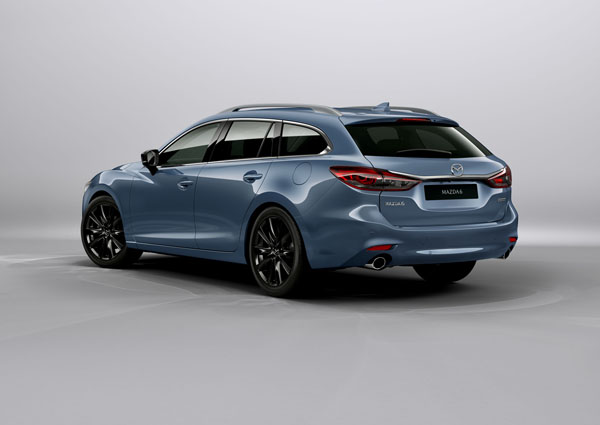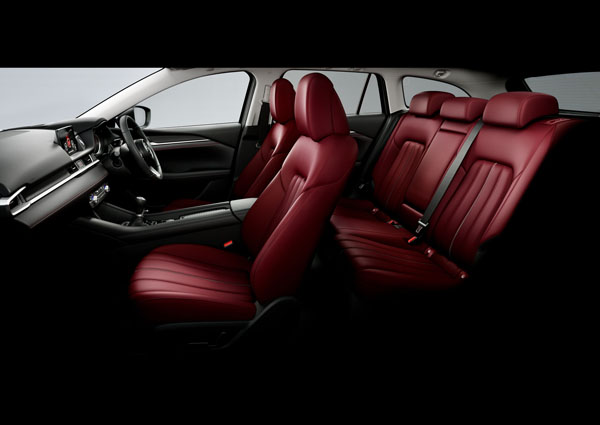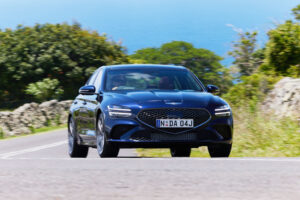
While SUVs and pickup trucks reign supreme on the world’s automobile markets, the humble sedan can only stand by, looking on in envy. One such observer, the Mazda6, has paid the price for this fickle sales atmosphere.
Despite this, the company has persisted with its mid-range passenger car in sedan and wagon form, while simplifying it to four variants – Sport, Touring, GT SP and Atenza.
New kid on the block is the GT SP, which according to Mazda Australia managing director Vinesh Bhindi, brings a distinctly sporty character to the range and builds on the local GT SP portfolio alongside the CX-9.
The GT SP, along with the range-topping Atenza, take on a turbocharged version of the 2.5-litre four-cylinder engine used across the range, developing 170 kW and 420 Nm. The Sport and Touring make do with the naturally aspirated unit delivering 140 kW and 252 Nm.
As well as engine enhancements, the GT SP boasts 19-inch alloy wheels, adaptive front lighting and leather upholstery on heated front and rear seating. The sedan sells for $46,690, plus on-road costs, the wagon $47,990.
The entry-level Sports sedan comes to market at a competitive $34,590, plus ORCs, the wagon $35,890. We were given a taste of the upgrades with the former.

STYLING
This is no white-bread model. In looks alone, the Mazda6 Sedan has earned the right to stand shoulder to shoulder with prestige product with a price sticker above and beyond its own.
With its sleek, coupe-style profile and 17-inch alloy wheels, the car commands attention.
The Mazda signature radiator grille is flanked by LED headlamps and daytime running lights, while rear lighting repeats the reliance on LED technology.
INTERIOR
Despite showing its age in decor, black cloth upholstery sets the scene with its look of quality, complemented by a leather wrapped steering wheel with paddle shifts. An electric park brake features a hold function.
Rear seat leg and shoulder room is good and dual zone climate control incorporates rear vents but getting in and out of the back is a chore because of a pinched door opening due to the swoopy nature of the sedan. Boot space is a usable 474 litres.
INFOTAINMENT
An 8-inch full colour touch screen atop the central dashboard displays info from the car’s MZD Connect system, including embedded satellite navigation. Bluetooth is hands-free capable and USB-audio input ports are iPod compatible. There’s a USB charging port in the rear seat armrest.

ENGINES / TRANSMISSIONS
Sport and Touring sedans and wagons feature Mazda’s well-respected Skyactiv-G 2.5-litre four-cylinder petrol engine, mated with a six-speed automatic transmission, driving the front wheels.
The set-up produces 140 kW of power at 6000 rpm and 252 Nm of torque at 4000 revs. On 91-octane unleaded petrol, fuel consumption is a claimed 7 litres per 100 kilometres on the combined urban / highway cycle.
SAFETY
A five-star safety rating is 2018 vintage. It includes intelligent speed assistance, smart city brake support, front and rear, lane departure warning, lane keep assist, blind spot monitoring, rear cross-traffic alert and driver attention alert.
Also fitted are rear parking sensors, high beam control, rear view mirror with auto dimming, reverse camera, traffic sign recognition and tyre pressure monitoring.
DRIVING
The Mazda6 Sport Sedan offered up a quirky welcome, with a nod to the past in that the doors are unlocked by use of a key fob button – no modern touch of the door handle here – and then discarded for a dash-mounted push button start to the engine.
A further minor beef is fitment of the old 8-inch Mazda MZD Connect infotainment system and not the newer Mazda Connect as in the Mazda3 and CX-30. However, the familiar Command Control knob on the centre console does make access to info easy while the vehicle is on the move.
Having said that, the entry-level Sport does what a mid-size passenger sedan is supposed to: carry occupants in comfort and safety and be a pleasure to drive. No worries.
The six-speed automatic transmission did much to do this smoothly and efficiently, while the suspension was up to taking the rough and tumble of some scratchy roads no matter what load the car was carting.
Don’t take the word ‘Sport’ literally. Performance is not the prerogative here. For that a step up is needed to the GT SP or Atenza, with the turbocharged 2.5-litre unit generating 170 kW at 5000 rpm and a robust 420 Nm at a low 2000 rpm.
Mazda claims the naturally aspirated 2.5-litre four-cylinder engine of the Sport uses 7 litres of fuel per 100 kilometres. The test car recorded 9.3 litres per 100 kilometres in the CBD and suburbs and 6.4 litres per 100 kilometres on the motorway.
SUMMARY
For those interested in buying a mid-size passenger car (are there any out there?) the Mazda6 Sedan serves the segment well.
AT A GLANCE
MODEL LINE-UP
Mazda6 2.5 Sport Sedan automatic $34,590
Mazda6 2.5 Touring Sedan (a) $38,890
Mazda6 2.5 GT SP Sedan (a) $46,690
Mazda6 2.5 Atenza Sedan (a) $50,090
Note: These prices do not include government or dealer delivery charges. Contact your local Mazda dealer for drive-away prices.
SPECIFICATIONS (Mazda6 Sport 2.5L 4-cylinder petrol, 6sp automatic, FWD sedan)
ENGINE:
Capacity: 2.488 litres
Configuration: Four cylinders in line
Maximum Power: 140 kW @ 6000 rpm
Maximum Torque: 252 Nm @ 4000 rpm
Fuel Type: Petrol 91 RON
Combined Fuel Cycle (ADR 81/02): 7.0 L/100km
DRIVELINE: Six-speed automatic, front-wheel drive
DIMENSIONS, WEIGHT AND CAPACITIES:
Length: 4865 mm
Wheelbase: 2830 mm
Width: 1840 mm
Height: 1450 mm
Turning Circle: 11.2 metres
Kerb Mass: 1537 kg
Fuel Tank Capacity: 62 litres
BRAKES:
Front: Ventilated disc
Rear: Disc
STANDARD WARRANTY:
Five years / unlimited kilometres








